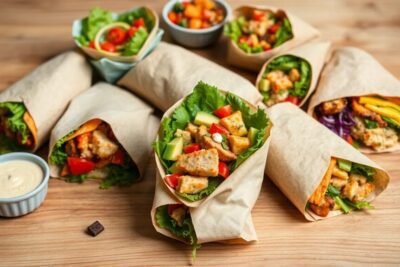
Delicious Diabetic-Friendly Haddock Recipes for a Healthier Lifestyle
- Introduction to Haddock and Diabetes Management
- Nutritional Benefits of Haddock
- Cooking Techniques for Diabetic-Friendly Haddock
- Simple and Tasty Fried Haddock Recipe
- Haddock and Vegetable Stir-Fry Recipe
- Baked Haddock with Lemon and Herbs Recipe
- Smoky Haddock Chowder Recipe
- Haddock Tacos: A Creative and Healthy Twist
- Tips for Meal Planning with Haddock
- Conclusion: Making Healthful Choices with Haddock
Introduction to Haddock and Diabetes Management
Haddock is a lean white fish that has gained recognition for its nutritional benefits, making it a valuable addition to a diabetic-friendly diet. Rich in protein and low in calories, haddock provides essential nutrients without compromising health goals. With a modest caloric content, it can support weight management, which is a crucial component in diabetes care. For those managing their blood sugar levels, the incorporation of low-calorie options such as haddock into one’s meals can facilitate better glycemic control.
One of the key highlights of haddock is its substantial omega-3 fatty acid content. Omega-3 fats are well-known for their heart-protective properties, which are particularly important for individuals with diabetes, given their heightened risk of cardiovascular diseases. Including fatty fish like haddock in a diet can help reduce inflammation and improve overall heart health. This nutrient-dense fish also contains vital vitamins and minerals such as vitamin B12, magnesium, and selenium, contributing to the nutritional diversity that is beneficial for diabetic individuals.
Moreover, seafood is an excellent source of lean proteins that can replace saturated fat-laden meats, thereby promoting healthier cooking and eating practices. This shift not only supports blood sugar levels but can also enhance the overall quality of one’s diet. As we explore various diabetic-friendly haddock recipes, it is essential to keep in mind these health benefits and how they can complement a well-rounded diabetes management plan.
By prioritizing seafood like haddock in daily meals, individuals can enjoy comforting and satisfying dishes without sacrificing their health. Utilizing diabetic friendly haddock recipes ensures that managing a diabetic lifestyle can be both delicious and nutritious.
Nutritional Benefits of Haddock
Haddock is a lean fish that offers numerous nutritional benefits, particularly for individuals managing diabetes. One of the key components of haddock is its high protein content. Protein is essential for maintaining muscle mass and can help regulate blood sugar levels. For those following diabetic-friendly haddock recipes, the protein will promote satiety and reduce the likelihood of overeating, making it a valuable inclusion in a balanced diet.
In addition to being rich in protein, haddock is an excellent source of various vitamins and minerals. Notably, it contains significant amounts of vitamin B12, which plays a crucial role in nerve function and the formation of red blood cells. This vitamin is particularly beneficial for individuals with diabetes, as it helps combat fatigue and supports overall energy levels. Additionally, haddock provides selenium, a mineral with antioxidant properties that may contribute to improved glucose metabolism.
Haddock is also low in fat, especially saturated fat, making it a heart-healthy option. The heart health of individuals with diabetes is especially important, as they are at a greater risk of developing cardiovascular diseases. Furthermore, the omega-3 fatty acids found in fish like haddock can help reduce inflammation and improve lipid profiles, which is another vital aspect of cardiovascular health.
Incorporating diabetic-friendly haddock recipes into one's diet can help fulfill nutritional requirements without compromising blood sugar control. By selecting recipes that showcase this nutrient-dense fish, individuals can enjoy its unparalleled health benefits while also satisfying their taste buds. The combination of protein, vitamins, and minerals in haddock makes it a smart choice for anyone aiming to maintain a healthier lifestyle and effectively manage diabetes.
Cooking Techniques for Diabetic-Friendly Haddock
When creating diabetic-friendly haddock recipes, the choice of cooking technique plays a vital role in ensuring that the meal remains nutritious while enhancing its flavor. Several methods are particularly suitable for preparing haddock, such as baking, grilling, and steaming, each offering unique benefits without compromising health.
Baking haddock is an excellent method for retaining its moisture while allowing for the use of minimal added fats. When baking, consider seasoning the fish with herbs and spices rather than relying on oils or butter, which can increase calorie and fat content. A simple recipe might involve placing the seasoned fish in a preheated oven at 375°F for about 15 to 20 minutes, ensuring the haddock is flaky yet retains its nutritional benefits.
Grilling is another favored technique that adds a delightful smoky flavor to haddock while promoting healthy cooking. By grilling the fish, one can achieve a crispy exterior without the need for excessive oils or sauces. To prepare, simply marinate the haddock in a mixture of lemon juice, garlic, and herbs before placing it on the grill. This method not only enhances taste but also encourages the use of fresh ingredients, essential in diabetic-friendly meals.
Steaming haddock is a further cooking technique that preserves the fish’s natural flavors and nutrients. This method allows for cooking without added fats and is perfect for maintaining the delicate texture of haddock. Steaming can be easily accomplished using a stovetop steamer or a microwave, ensuring the fish is cooked through while staying moist. Accompany the steamed haddock with a side of vegetables or a light sauce made from low-sodium broth to enhance the dish while keeping it diabetes-friendly.
Overall, employing these cooking techniques can help you create delicious diabetic-friendly haddock recipes that align with health-conscious eating habits, allowing for enjoyable meals without compromising on taste or nutrition.
Simple and Tasty Fried Haddock Recipe
Fried haddock can be an excellent addition to a diabetic-friendly diet when prepared mindfully. This simple and tasty recipe incorporates low-carbohydrate ingredients, making it suitable for individuals aiming to maintain stable blood sugar levels while enjoying flavorful meals. Below are the components needed and step-by-step instructions to create this delicious dish.
Ingredients:
- 4 pieces of fresh haddock fillets (about 6 ounces each)
- 1 cup of almond flour or a low-carb alternative
- 1 teaspoon of garlic powder
- ½ teaspoon of paprika
- Salt and pepper to taste
- 2 large eggs, beaten
- 2 tablespoons of olive oil or coconut oil for frying
- Lemon wedges for serving
Instructions:
- Start by preparing your haddock fillets. Pat them dry with paper towels to remove excess moisture. This step is crucial for achieving a crispy texture in the frying process.
- In a shallow dish, combine the almond flour, garlic powder, paprika, salt, and pepper. Mix these dry ingredients thoroughly; this will serve as your batter.
- In another dish, whisk the eggs until well combined. This will be used to help the batter adhere to the fish.
- Dip each fillet first into the egg wash, allowing any excess to drip off, then coat the fillet with the almond flour mixture, ensuring an even layer on all sides.
- Heat the olive oil in a large skillet over medium heat. Once the oil is hot, add the battered haddock fillets and cook for 4 to 5 minutes on one side or until golden brown. Carefully flip the fillets and repeat on the other side.
- Once cooked through, remove the fillets from the skillet and place them on a plate lined with paper towels to absorb any excess oil.
- Serve hot with fresh lemon wedges on the side, enhancing the flavors while keeping the dish diabetic-friendly.
This simple fried haddock recipe is not only straightforward but also adaptable. By incorporating spices of your choice or experimenting with dipping sauces made from low-carb ingredients, you can create a variety of diabetic-friendly haddock recipes that suit your palate without compromising your health.
Haddock and Vegetable Stir-Fry Recipe
Incorporating fresh, colorful vegetables into meals not only enhances the visual appeal of dishes but also significantly boosts their nutritional content. This vibrant haddock and vegetable stir-fry recipe exemplifies how you can create a diabetic-friendly meal that is both delicious and satisfying. Utilizing low-glycemic vegetables like bell peppers, broccoli, and zucchini, this dish is particularly beneficial for those managing diabetes as it helps to maintain stable blood sugar levels.
To prepare this healthy dish, begin by selecting a fresh haddock fillet. Haddock is an excellent source of lean protein, making it a perfect choice for a diabetic-friendly meal. First, cut the fillet into bite-sized pieces and marinate them in a mixture of low-sodium soy sauce, minced garlic, and ginger for approximately 15 minutes. This step infuses the fish with flavor while keeping the calorie count low.
Next, heat a tablespoon of olive oil in a large non-stick skillet or wok over medium-high heat. Adding the marinated haddock, cook until the pieces are slightly golden and cooked through, approximately 3 to 4 minutes. Following this, introduce your selected vegetables, stirring continually. Broccoli florets, sliced bell peppers, and thinly sliced zucchini not only contribute to a rainbow of colors but also provide important vitamins and minerals. Cook these veggies until they are bright and crispy, about 5 to 7 minutes.
For added flavor, consider sprinkling in some sesame seeds or serving the dish with a side of quinoa or brown rice, which complement the flavors without raising the glycemic impact. This haddock and vegetable stir-fry showcases how one can enjoy a flavorful, balanced, and diabetic-friendly meal, highlighting the importance of incorporating a variety of vegetables into one’s diet.
Baked Haddock with Lemon and Herbs Recipe
When it comes to preparing diabetic-friendly haddock recipes, simplicity and flavor are key components. This baked haddock with lemon and herbs is a delightful choice that not only meets dietary restrictions but also highlights the fish’s natural taste. The light and refreshing combination of herbs and lemon makes this dish a perfect option for a healthy dinner.
To create this dish, you will need a few essential ingredients: fresh haddock fillets, extra virgin olive oil, freshly squeezed lemon juice, garlic, parsley, and a selection of your favorite herbs, such as thyme and rosemary. These ingredients are not only easy to find but also enhance the delicate flavor of the fish without adding unnecessary calories or carbohydrates.
To begin, preheat your oven to 375°F (190°C). Lightly grease a baking dish with olive oil. Next, place the haddock fillets in the dish, ensuring they have enough space to cook evenly. Drizzle the fillets with olive oil and squeeze fresh lemon juice over them for a tangy kick. Sprinkle minced garlic, finely chopped parsley, and your chosen herbs over the top of the fish. These aromatic components contribute to a vibrant flavor profile while also being compliant with diabetic dietary needs.
Once you have prepared the fillets, cover the dish with aluminum foil to retain moisture and ensure the fish cooks perfectly. Bake for approximately 15 to 20 minutes, or until the haddock flakes easily with a fork and is cooked through. This method keeps the fish tender and flavorful, making it an ideal dish for anyone looking for nutritious diabetic-friendly haddock recipes.
Serve with a side of steamed vegetables or a fresh salad to complete this healthy meal. This baked haddock with lemon and herbs offers a wonderful balance of flavors while being mindful of your health and dietary restrictions.
Smoky Haddock Chowder Recipe
This Smoky Haddock Chowder is an excellent choice for those seeking a comforting meal that aligns with diabetic-friendly dietary needs. Crafted with an assortment of wholesome ingredients, this recipe emphasizes the importance of selecting low-fat alternatives and high-fiber additions to maintain a healthy lifestyle without compromising flavor. The creamy texture of chowder is traditionally associated with high-calorie ingredients, but this version uses healthy thickeners that keep fat and carbs in check.
To begin, gather the following ingredients: 1 pound of smoked haddock fillets, 1 medium onion (chopped), 2 garlic cloves (minced), 2 medium potatoes (peeled and diced), 1 cup of low-sodium vegetable broth, 2 cups of low-fat milk or a non-dairy alternative, and 1 cup of frozen peas. For seasoning, use fresh herbs such as parsley and dill, salt, and pepper to taste. These elements contribute not only to the flavor profile but also to a sophisticated presentation that is pleasing to the eye.
Commence by sautéing the onion and garlic in a non-stick pot until soft. Next, introduce the diced potatoes and vegetable broth, cooking until the potatoes are tender. Incorporate the smoked haddock and allow it to infuse the chowder with its rich, smoky flavor. Gradually add the low-fat milk while stirring, and bring the mixture to a gentle simmer. The use of low-fat dairy products not only reduces overall calories but also ensures the chowder remains creamy without the excessive fat typically found in traditional recipes.
Finally, add frozen peas for a burst of color and nutrition, cooking for an additional few minutes. Adjust the seasoning to your preference and serve hot, garnished with fresh herbs. This smoky haddock chowder is not just simplistic in its recipe but remains a fulfilling meal option for those adhering to diabetic-friendly haddock recipes or anyone seeking a healthier lifestyle.
Haddock Tacos: A Creative and Healthy Twist
Haddock tacos offer a delightful way to enjoy a classic dish while adhering to a diabetic-friendly lifestyle. This recipe emphasizes the use of low-carb tortilla alternatives, which can help manage blood sugar levels without compromising on flavor. Almond flour or cauliflower-based tortillas serve as excellent substitutes, providing a nutritious base for the tacos while keeping the carbohydrate content low. These alternatives not only enhance the taste but also contribute essential nutrients suitable for individuals monitoring their dietary intake.
The preparation of the haddock itself is equally simple and health-conscious. Start by seasoning fresh haddock fillets with a blend of spices, such as cumin, paprika, and garlic powder, to add depth without unnecessary calories. Cooking the fish through methods like baking or grilling ensures that the haddock maintains its tenderness and flavor while minimizing added fats. Aiming for a cooking temperature of around 375°F for 15-20 minutes usually yields the ideal texture.
Moreover, fresh salsa can elevate your haddock tacos, ensuring they remain both tasty and diabetic-friendly. Combine diced tomatoes, red onions, cilantro, and a splash of lime juice for a refreshing topping that enhances your dish. Avocados can also be a great addition, offering healthy fats that support heart health, making the tacos even more nutritious. Feel free to experiment with various veggies such as bell peppers and zucchini, ensuring they harmonize well with your salsa and offers a great texture contrast to the delicate haddock.
These haddock tacos present an exciting culinary adventure for anyone seeking healthy, diabetic-friendly recipes. By using low-carb options and maximizing fresh ingredients, this dish not only satisfies but also ensures you can enjoy mealtime without excess worry about blood sugar spikes.
Tips for Meal Planning with Haddock
When incorporating diabetic-friendly haddock recipes into your weekly meal plans, organization and strategy are key. Meal planning not only aids in managing diabetes but also saves time and effort during the week. Start by selecting a variety of haddock recipes, focusing on those that balance protein with healthy fats and low-glycemic carbohydrates. Keeping your choices diverse reduces mealtime monotony and encourages a balanced intake of nutrients.
Batch cooking is a highly effective technique for managing meal preparation. Consider preparing several servings of a chosen haddock recipe at once. After cooking, allow the dishes to cool completely before storing them in airtight containers. This practice not only preserves freshness but also enables easy reheating throughout the week. Opt for recipes that can be frozen as well; dishes like haddock chowder or haddock baked with vegetables can be frozen for longer storage. Just ensure to label the containers with date and contents for easy reference.
When it comes to pairs and sides that complement your haddock dishes, focus on non-starchy vegetables and whole grains. Steamed broccoli, roasted Brussels sprouts, or a colorful mixed salad are ideal companions that enhance the flavors without adding excess carbohydrates. Quinoa or brown rice can serve as nutritious sides, offering fiber and nutrients that are essential for blood sugar management. Accompanying your meals with these options allows for overall meal balance while adhering to diabetic-friendly principles.
By planning your weekly menu with these tips in mind, you can create delicious diabetic-friendly haddock recipes that not only satisfy your palate but also support your health goals. Meal prepping, selecting complementary sides, and ensuring variety will play a crucial role in your overall dietary success.
Conclusion: Making Healthful Choices with Haddock
Incorporating haddock into a diabetic-friendly diet presents a myriad of health benefits that can assist individuals in managing their condition while enjoying delicious meals. Haddock, a lean source of protein, is low in calories and saturated fat, making it an ideal choice for those monitoring their blood sugar levels. Its rich array of nutrients, including omega-3 fatty acids, vitamins, and minerals, not only supports overall health but may also contribute positively to heart health, which is particularly crucial for individuals with diabetes.
The diabetic-friendly haddock recipes shared throughout this blog post provide a variety of options that can cater to diverse palates. Whether grilled, baked, or sautéed, haddock can easily be paired with non-starchy vegetables, whole grains, or healthy fats, creating balanced and flavorful meals. These recipes highlight that adhering to a diabetic-friendly diet does not mean sacrificing taste or enjoyment. Instead, they showcase how it is possible to create meals that are both nutritious and satisfying.
Encouraging readers to experiment with these recipes can foster a more health-conscious approach to eating. Trying out different seasoning blends or preparation methods can introduce an exciting dimension to meal planning. As individuals navigate the challenges of managing diabetes, it is essential to remember that making healthful choices can lead to one’s well-being and enjoyment in meal times.
Ultimately, adopting diabetic-friendly haddock recipes into weekly meal rotations offers a delicious path toward better health. By embracing a variety of cooking styles and flavor combinations, individuals can discover new favorites while effectively managing their diabetes. Eating well is an integral part of a balanced lifestyle, and incorporating haddock provides a flavorful approach to achieving those goals.










